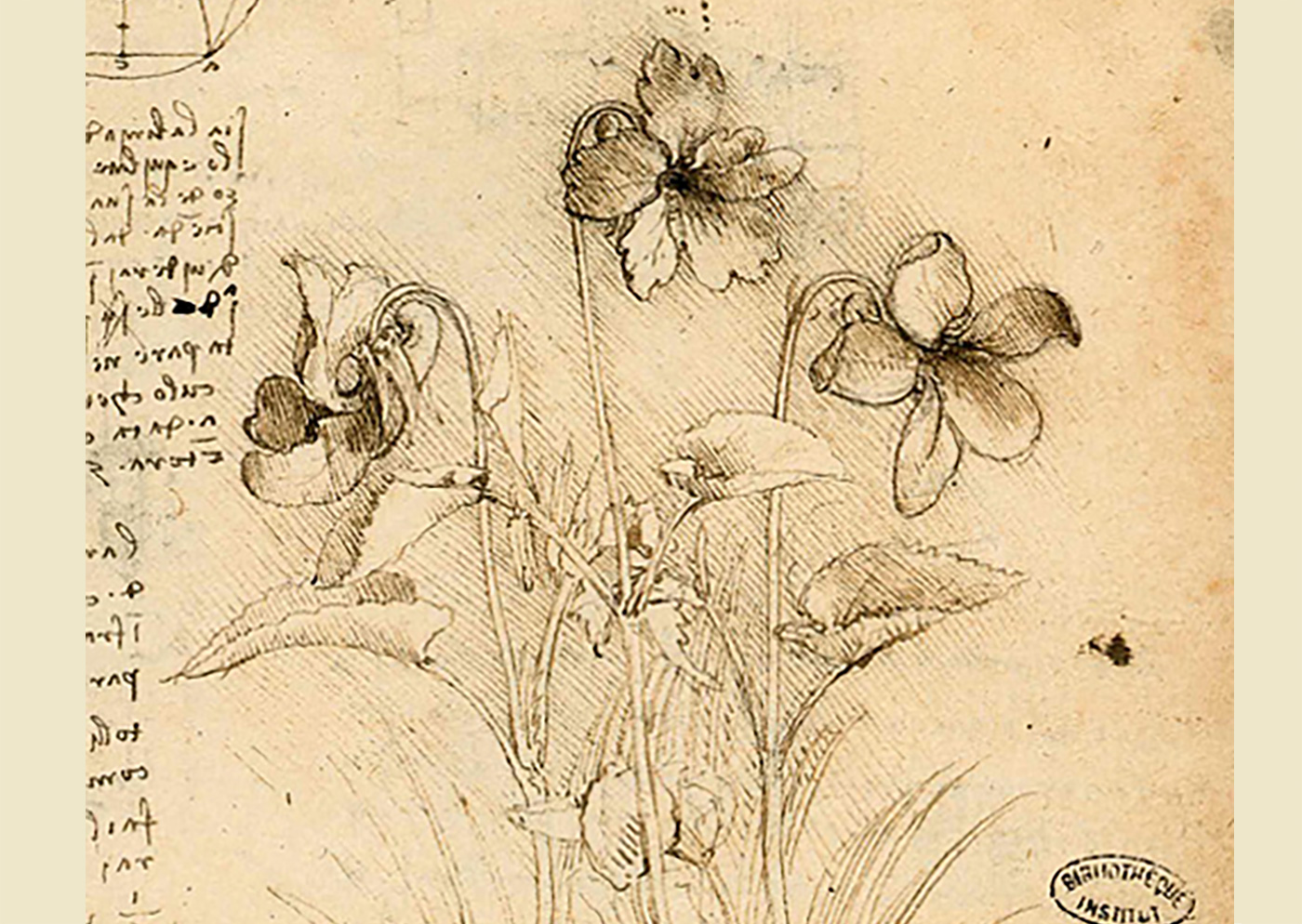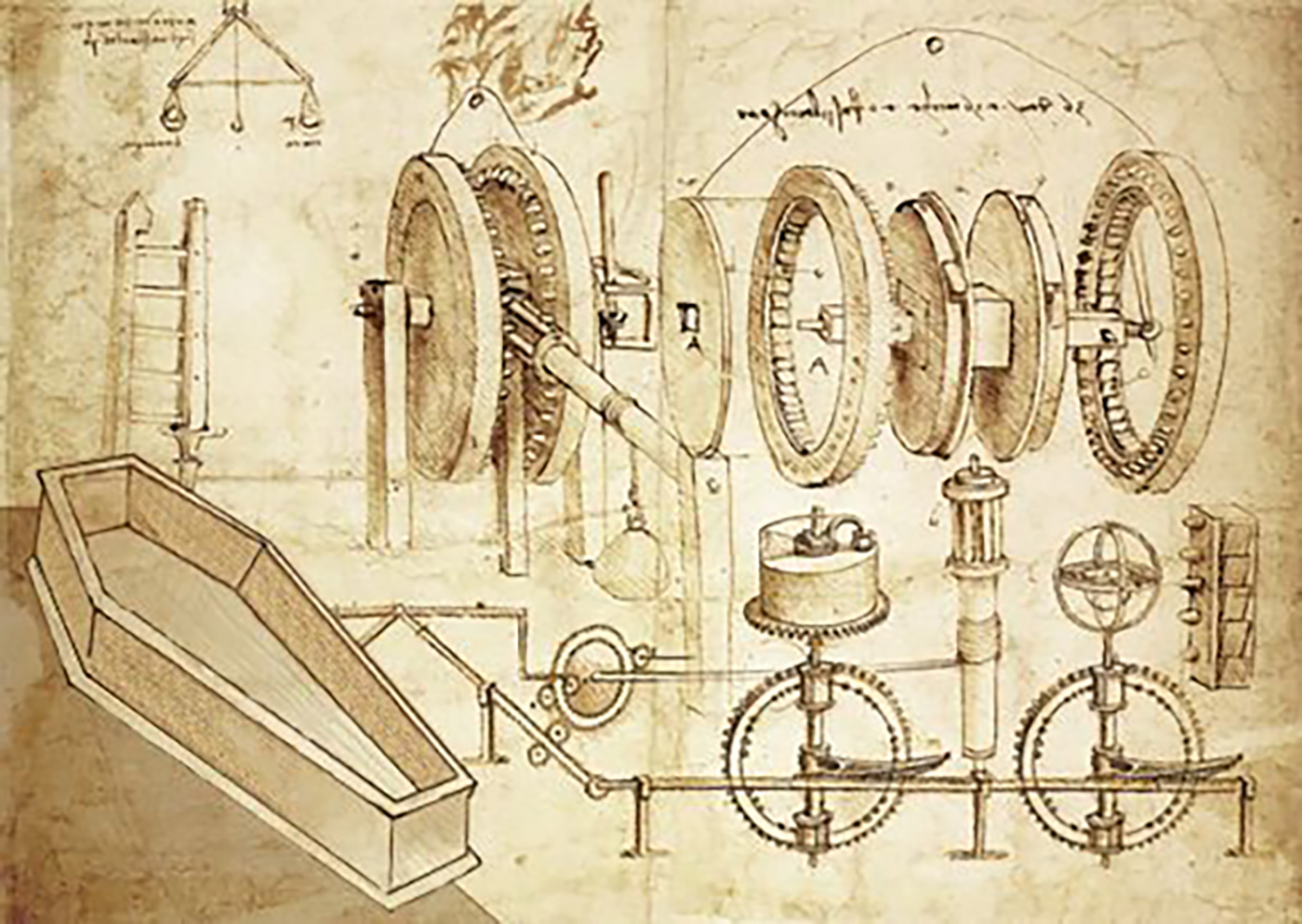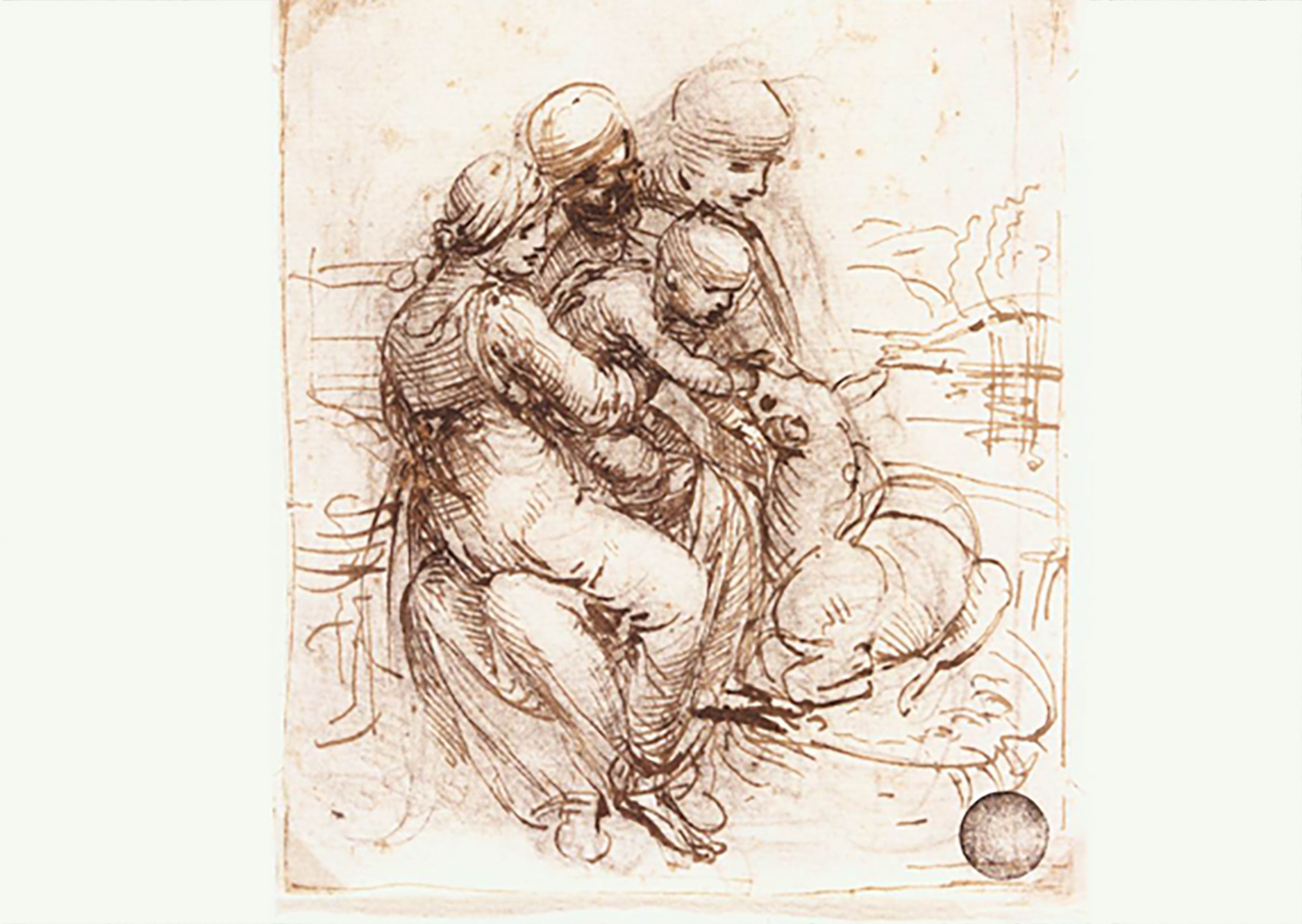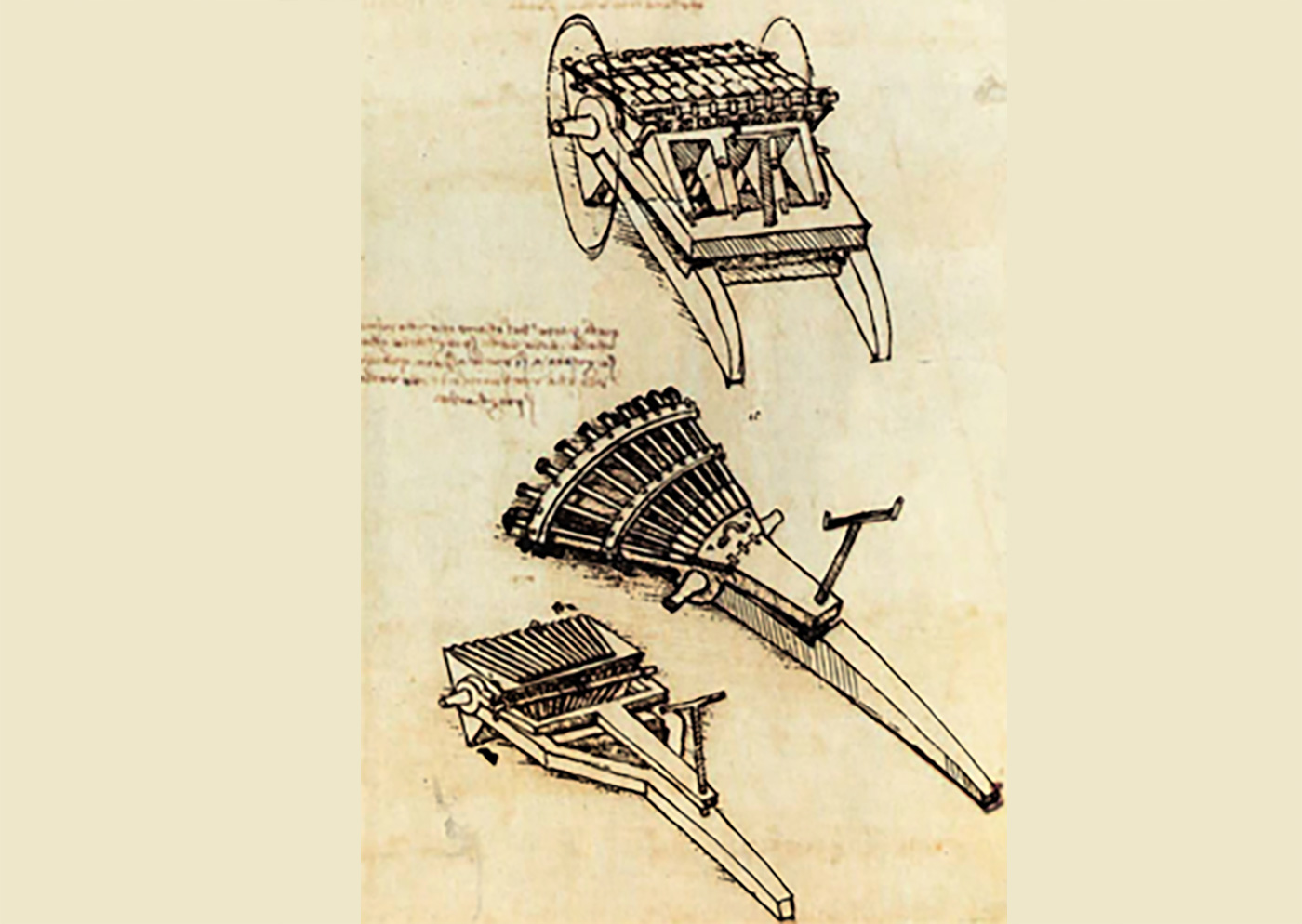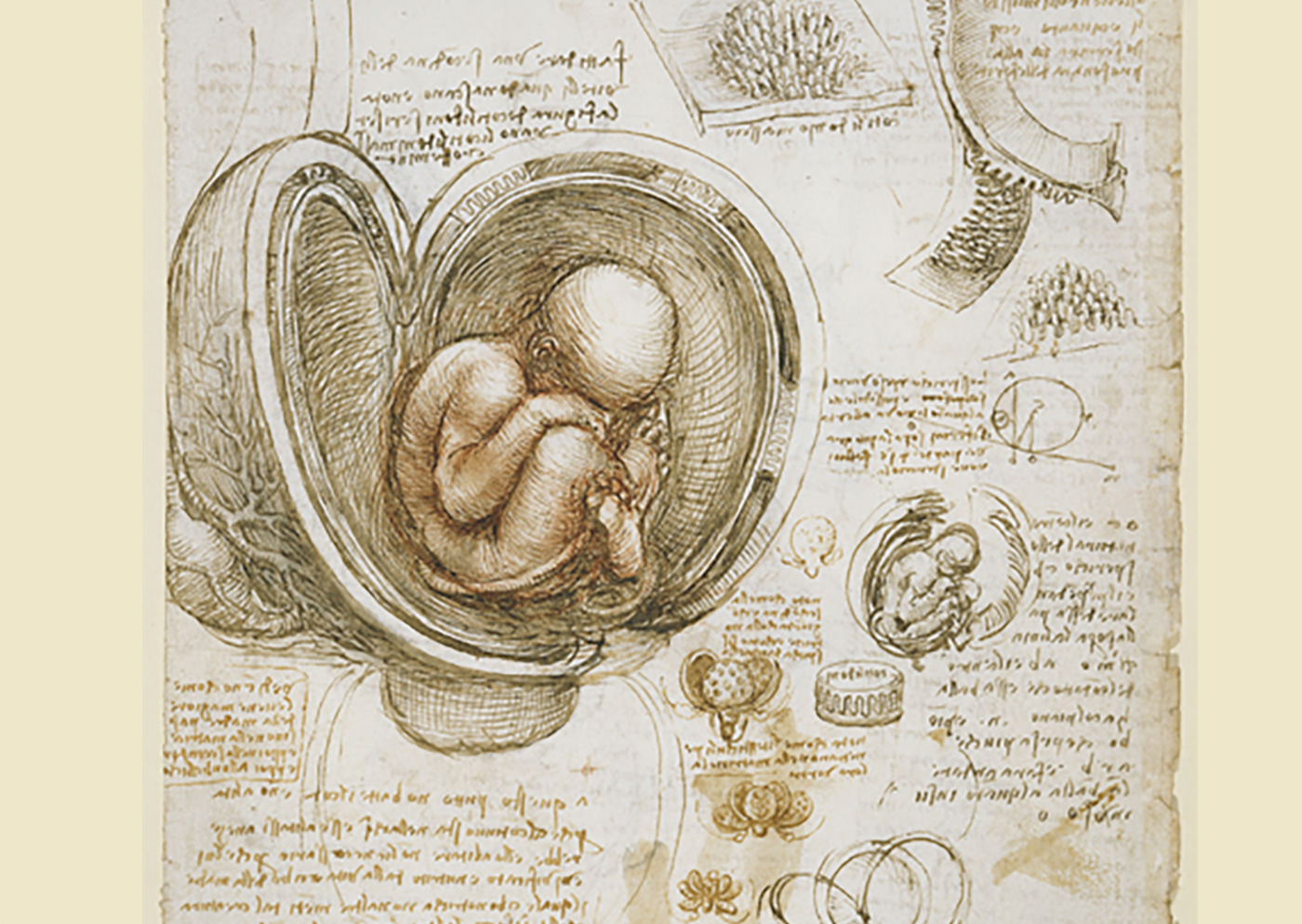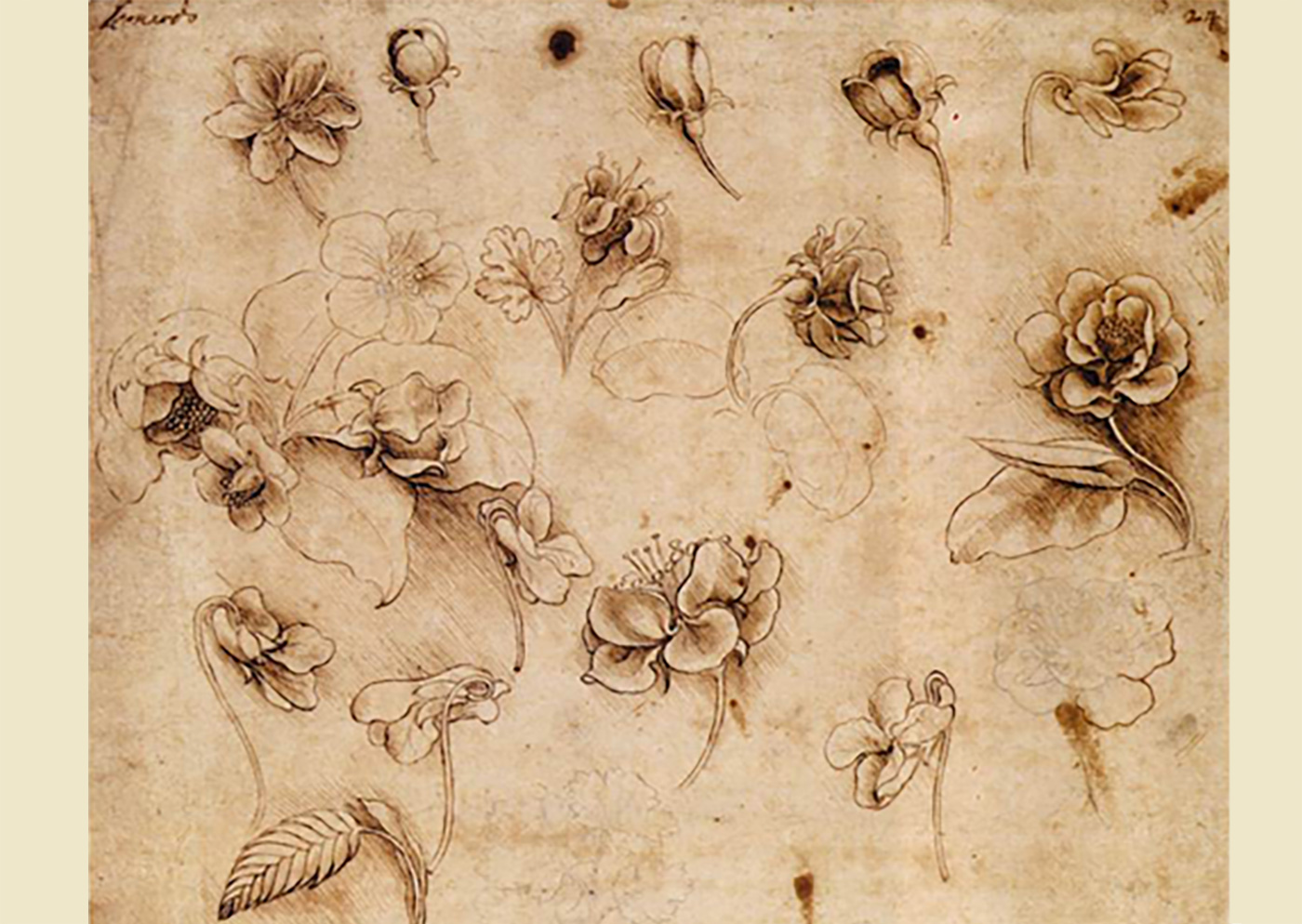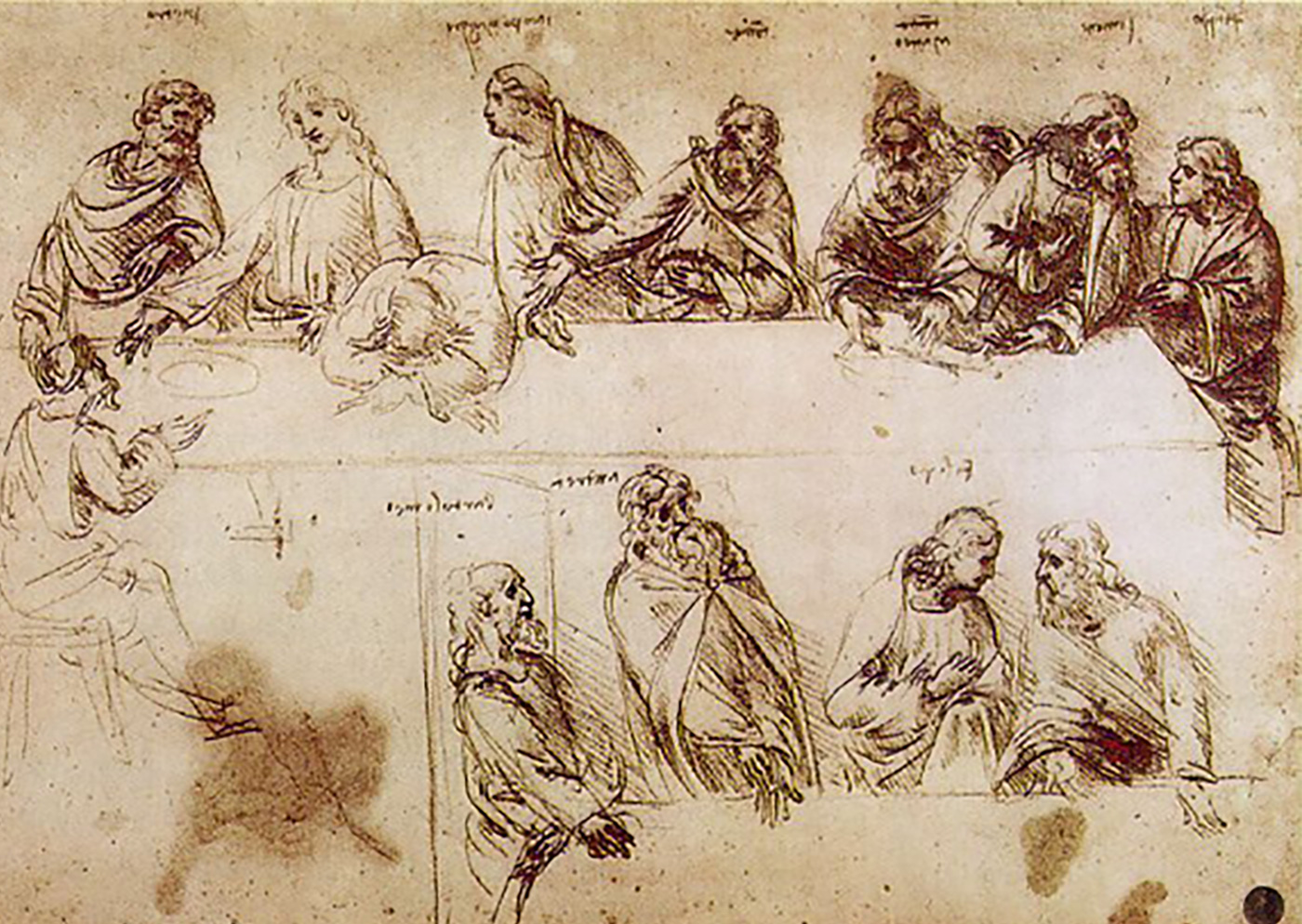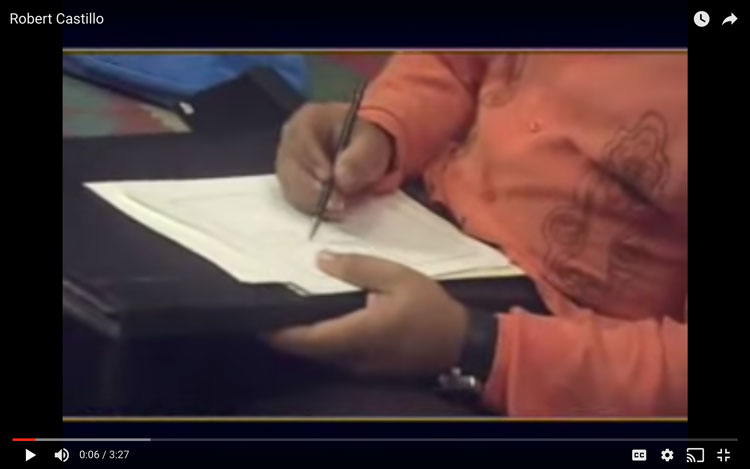Artists keep sketchbooks to record observations, hone artistic skill and develop ideas. Artists and designers alike keep an ongoing journal to practice their drawing technique and develop ideas and products.
Besides an inspiring name for a mutant turtle in a secret underground ninja order, Leonardo was an extremely talented boy from the town of Vinci during the mid 1400’s. People who knew him recognized his creative talents, studying and drawing subjects from a wide range of topics and studies, from architecture to zoology. After becoming an apprentice to the Masters of his time, Leonardo would become the Master of Masters. Along side legendary works like the Mona Lisa and The Last Supper, Leonardo’s sketchbook pages, numbering in the thousands, stands as a collective master piece of not only drawing, and illustration but of human investigation his spirit for curiosity.
Learning Targets
Leonard da Vinci’s Sketches
.
Question to Consider
What do you suppose (I think) the contraption was designed to do? What evidence (because) can you use to support your idea?
.
Question to Consider
Looking at exceptional master works can be a daunting for a student as well as is inspiring, it may drum up feelings that the skills are too hard to learn. All artists feel this way, start off small and practice the your skills for even just a few moments each day. Illustrator Mark Crilley gave a drawing challenge his friends, “The rules are simple – each has to pick a character and sketch it three times by hand in 10 minutes, 1 minute, and 10 seconds.” In the featured article Greta, J. shares an array artists and images that reveal the artistic process and gradual progression of shape and form in a subject.
Asks Artists To Sketch In 10 Mins, 1 Min,
And 10 Seconds.
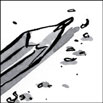 Sketching: The Visual Thinking Power Tool
Sketching: The Visual Thinking Power Tool
The 3 best reasons to carry a sketchbook with suggestions for those who don’t think they can draw very well. How does sketching help artists develop a variety of ideas? What are alternative ideas and rabbit-hole ideas? Why can sketches be more inviting of team discussions than highly finished art?
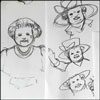 Corgis and crowns: Steve Antony’s Sketchpad Share in Pictures
Corgis and crowns: Steve Antony’s Sketchpad Share in Pictures
Explore the sketches, analyze the the use of shape and repetition what gives the characters such refinement? How does repetition help an artist develop ideas? How does the artist show variety, unity, and/or movement in the work?
Terms and Concepts
Composition, an arrangement of line, shape, form, space, value, pattern and color or value.
Crosshatching lines, a series of crossing lines to create values, esp. pen & ink
Depth, the illusion of real space on a flat surface.
Line, varied weight, a line that changes thickness.
Shape, two dimensional enclosed areas, circle, square, etc.
Sketchbook, a book to practice drawing, formulate ideas and keep visual resources
Space & Structure, organization or composition of shapes, lines and forms in a picture.
Thumbnails, many small drawings that are studies for larger works of art.
Value, an element of design that relates to the lightness and darkness of a color or tone.
Robert Castillo – Story Board Artist
Questions to Ponder
Questions to consider
How old was Robert when he came to the United States?
Recall what city did he come from?
Relate the feeling he describes of the cold air hitting him for the first time.
What conflicts arise for Robert as he first arrives in New York Cite evidence?
Why do think he felt conflicted meeting his mother the first time?
Materials
Students will need a sketchbook that they can use to sketch and draw in daily. A spiral sketchbook with white unlined pages works best, glued binders tend to fall apart after a while. A variety of sketchbooks are available at art supply stores and online or you can construct on in class. Below are a typical brands of sketchbooks you will find online or at a store near you.

Sketchbook Guide and Rubrics
• Cover each page with a variety of thumbnails, sketches, drawings and notes.
• Use thumbnail frames at first and mix frameless sketches into the page.
• Leave a little space, called gutters, between frames and the edges of the page.
• Sketch lightly at first, and darken lines later with a variety of dark and light lines.
• Create a variety of five to seven different values of gray, and work in some contrast.
• Add pattern, textures, and details, and other observations of the subject.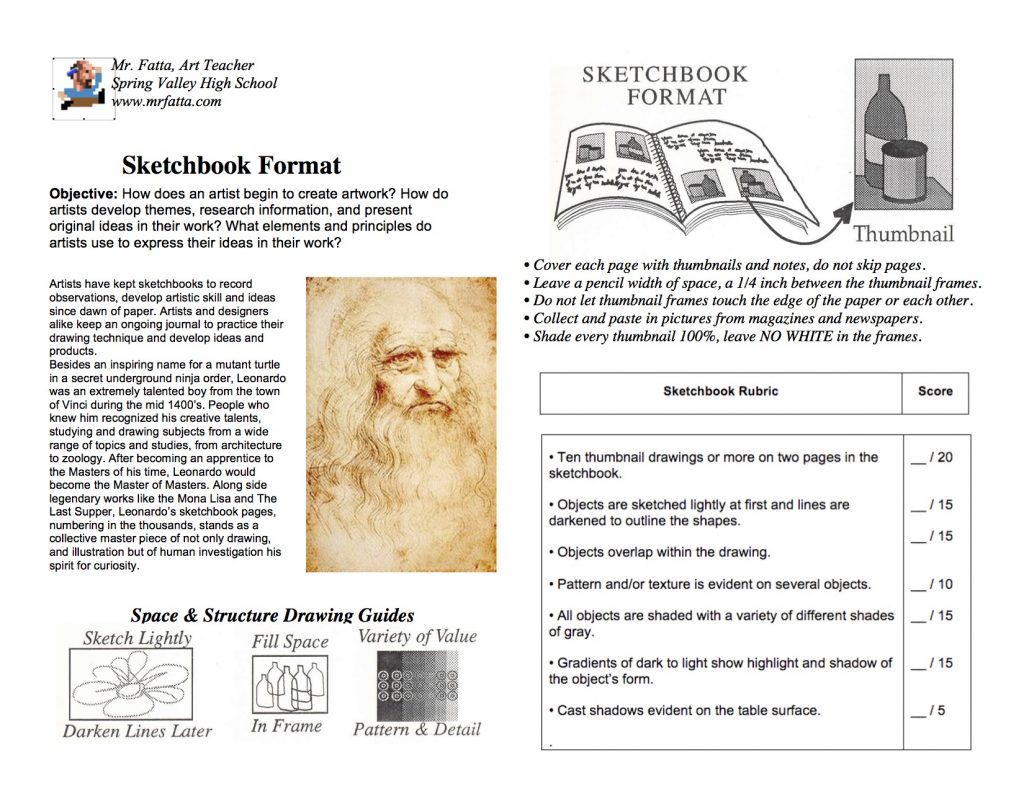 Sketchbook Format Español Link
Sketchbook Format Español Link
 * Cast shadows, presente sombras _/10
* Cast shadows, presente sombras _/10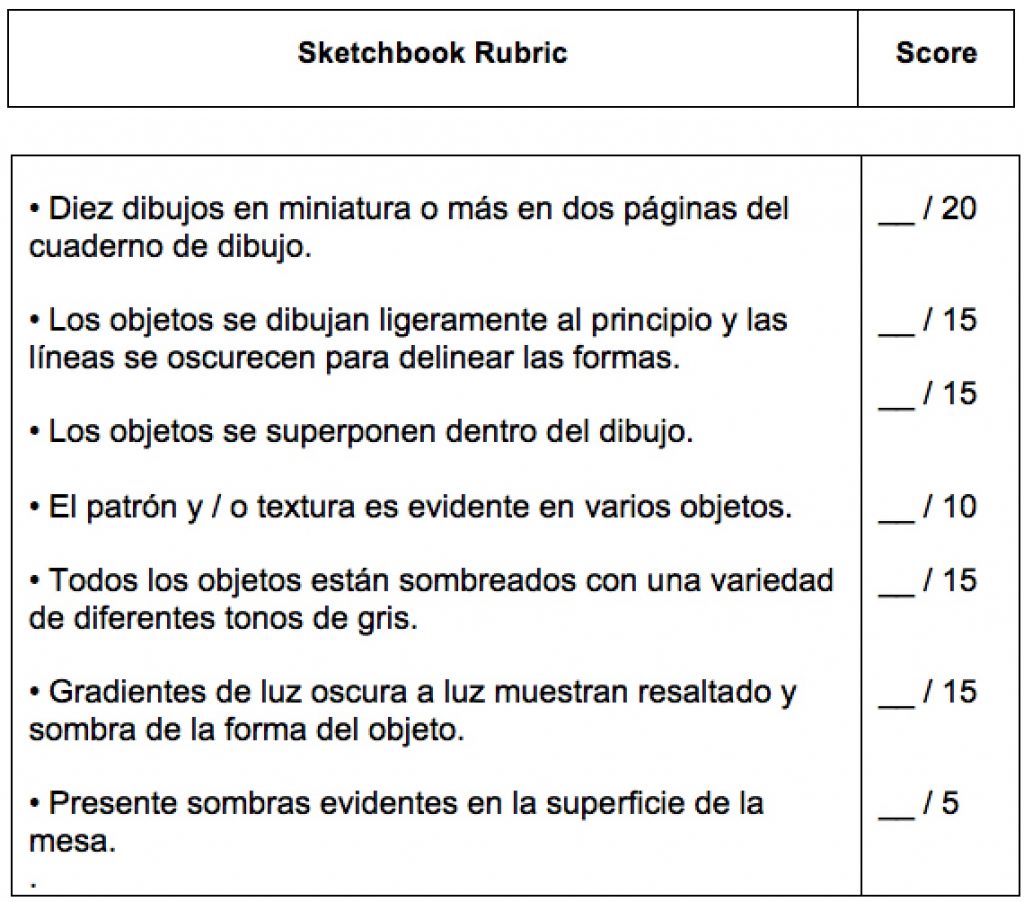
Citations
Mends, D., Leonardo da Vinci Drawings, Retrieved from http://www.howtodrawjourney.com/leonardo-da-vinci-drawings.html
Greta, J. Speed Drawing Challenge Asks Artists To Sketch In 10 Mins, 1 Min, And 10 Secs., Boredpanda.com, Retrieved 1/25/2017 http://www.boredpanda.com/speed-drawing-challenge/
Rohde, M. Sketching: the Visual Thinking Power Tool, A List Apart, Retrieved 1/25/2017, http://alistapart.com/article/sketching-the-visual-thinking-power-tool
Anthony, S. Corgis and crown Steve Anthony’s Sketchpad Share in Pictures, The Guardian, Retrieved 1/25/2017 https://www.theguardian.com/books/gallery/2017/jan/02/corgis-and-crowns-steve-antonys-sketchpad-share-in-pictures
Questions to Consider
What are the different parts of Georgia O’keeffe’s Landscapes?
How are Georgia’s Landscape paintings similar to her flower paintings?
How did the New Mexico environment effect her painting?
What aspects of the desert environment did she use in her painting?
How are her paintings similar to the photos of New Mexico?What details of the desert was she able to capture in her paintings?Which do you suppose she enjoyed painting more NY city or the desert?Why do you assume that position, what evidence do you have?
The National Core Arts Standards The Visual Arts Standards provide learning progressions from Pre k-12.
Creating
VA:Cr1.1.HSI Use multiple approaches to begin creative endeavors.
VA:Cr1.2.HSI Shape an artistic investigation of an aspect of present-day life using a contemporary practice of art or design.
VA:Cr2.1.HSI Engage in making a work of art or design without having a preconceived plan.
VA:Cr3.1.HSI Apply relevant criteria from traditional and contemporary cultural contexts to examine, reflect on, and plan revisions for works of art and design in progress.
Presenting
VA:Pr.4.1.HSI Analyze, select, and curate artifacts and/or artworks for presentation and preservation.
VA:Pr5.1.HSI Analyze and evaluate the reasons and ways an exhibition is presented.
Responding
VA:Re7.1.HSI Hypothesize ways in which art influences perception and understanding of human experiences.
VA:Re7.2.HSI Analyze how one’s understanding of the world is affected by experiencing visual imagery.
VA:Re9.1.HSI Establish relevant criteria in order to evaluate a work of art or collection of works.
Connecting
VA:Cn10.1.HSI Document the process of developing ideas from early stages to fully elaborated ideas.
VA:Cn11.1.HSI Describe how knowledge of culture, traditions, and history may influence personal responses to art.
National Core Arts Standards Visual Arts include the traditional fine arts such as drawing, painting, printmaking, photography, and sculpture; media arts including film, graphic communications, animation, and emerging technologies; architectural, environmental, and industrial arts such as urban, interior, product, and landscape design; folk arts; and works of art such as ceramics, fibers, jewelry, works in wood, paper, and other materials.
Construction Area
[tabs slidertype="top tabs" fx="fade"] [tabcontainer] [tabtext]1[/tabtext] [tabtext]2[/tabtext] [tabtext]3[/tabtext] [tabtext]4[/tabtext] [tabtext]5[/tabtext] [tabtext]6[/tabtext] [tabtext]7[/tabtext] [tabtext]8[/tabtext] [tabtext]9[/tabtext] [tabtext]10[/tabtext] [/tabcontainer] [tabcontent] [tab]I can construct a sketchbook by folding large sheets of paper in half and stapling them to create the center binder.[/tab] [tab]I can simplify complex objects by analyzing the object’s parts and their basic geometric shapes. [/tab] [tab]I can analyze an object by lightly sketching and arranging the basic geometrical shapes.[/tab] [tab]I can refine my rough analytical sketch by darkening lines that best define the object, and erasing the others.[/tab] [tab]I can create space and depth in a drawing by shading with a variety of values of gray.[/tab] [tab]I can create a visual interest in a drawing by adding areas of pattern and drawing details within the composition.[/tab] [tab]I can refine my drawings by sharpening edges of shapes, erasing stray marks, shading smoothly with variety, and adding details and pattern.[/tab] [tab]I can improve my sketching and drawing skills by creating multiple thumbnail compositions, trying different techniques, and filling each page with 4 or more practice drawings.[/tab] [tab]I can assess, refine, and evaluate my drawings by comparing them to the components listed in the project rubric and adding attributes that are missing or need more refining.[/tab] [tab]I can develop a thoughtfully composed work of art by analyzing the effective qualuties and features of my sketches and developing ideas I find attractive further in works outside my sketchbook.[/tab] [/tabcontent] [/tabs][tabs slidertype="top tabs" fx="fade"] [tabcontainer] [tabtext]1[/tabtext] [tabtext]2[/tabtext] [tabtext]3[/tabtext] [tabtext]4[/tabtext] [tabtext]5[/tabtext] [tabtext]6[/tabtext] [tabtext]7[/tabtext] [tabtext]8[/tabtext] [tabtext]9[/tabtext] [tabtext]10[/tabtext] [/tabcontainer] [tabcontent] [tab]I can construct a sketchbook by folding large sheets of paper in half and stapling them to create the center binder.[/tab] [tab]I can simplify complex objects by analyzing the object’s parts and their basic geometric shapes. [/tab] [tab]I can analyze an object by lightly sketching and arranging the basic geometrical shapes.[/tab] [tab]I can refine my rough analytical sketch by darkening lines that best define the object, and erasing the others.[/tab] [tab]I can create space and depth in a drawing by shading with a variety of values of gray.[/tab] [tab]I can create a visual interest in a drawing by adding areas of pattern and drawing details within the composition.[/tab] [tab]I can refine my drawings by sharpening edges of shapes, erasing stray marks, shading smoothly with variety, and adding details and pattern.[/tab] [tab]I can improve my sketching and drawing skills by creating multiple thumbnail compositions, trying different techniques, and filling each page with 4 or more practice drawings.[/tab] [tab]I can assess, refine, and evaluate my drawings by comparing them to the components listed in the project rubric and adding attributes that are missing or need more refining.[/tab] [tab]I can develop a thoughtfully composed work of art by analyzing the effective qualuties and features of my sketches and developing ideas I find attractive further in works outside my sketchbook.[/tab] [/tabcontent] [/tabs]